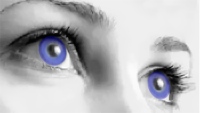|
The tears your eyes produce are necessary for overall eye health
and clear vision. Dry eye means that your eyes do not produce
enough tears or that you produce tears that do not have the
proper chemical composition. Dry eye is more common as we age.
It can also be caused by blinking or
eyelid problems, medications like antihistamines, oral
contraceptives and antidepressants, a dry climate, wind and
dust, general health problems like arthritis or Sjogren's
syndrome and chemical or thermal burns to your eyes.
 |
|
If you have dry eye, your symptoms may include irritated,
scratchy, dry, uncomfortable or red eyes, a burning sensation,
excessive tearing, blurred vision, or a
feeling of something foreign in your eyes.
Excessive dry eyes may damage eye tissue, scar your cornea (the
front covering of your eyes) and impair vision and make contact
lens wear difficult.
|
Any condition that
reduces the production, alters the composition, or impedes the
distribution of the preocular tear film (POTF) may cause a
noticeable irritation to the structures of the front surface of
the eye and a degradation of vision. These conditions are often
related to problems with the structure or function of the
eyelids, cornea, or conjunctiva. Depending upon the severity of
symptoms, individuals may be limited in their ability to see
clearly and comfortably and may be at increased risk of
developing secondary infection or chronic inflammation that may
not respond to treatment.
The two most commonly encountered ocular surface disorders are
tear film disorders and blepharitis. Additional
subclassifications include those dry-eye states associated
with systemic connective tissue disorders, specifically Sjogren
syndrome (SS). With regard to lipid deficient tear-film
disorders, the involvement of meibomian gland dysfunction (MGD)
has been proposed. |